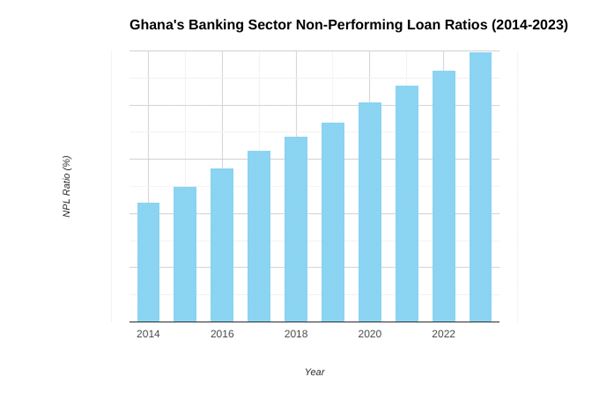By Joshua Worlasi AMLANU & Ebenezer Chike Adjei NJOKU
The banking industry’s non-performing loans (NPLs) continue to climb, driven by a cocktail of factors including ever-increasing government arrears, macroeconomic instabilities, poor credit risk management and high fiscal deficits, a new study has shown.
Last week, during a press briefing at the 19th meeting of the Monetary Policy Committee’s (MPC) conclusion, Bank of Ghana (BoG) Governor Dr. Ernest Addison disclosed that the industry’s NPL ratio had jumped to 24.1 percent in June 2024 from 18.7 percent during the comparable period of 2023, highlighting elevated credit risk in the system.
A comprehensive review by banking consultant Dr. Richmond Akwasi Atuahene reveals that these factors have increased NPLs, threatening the sector’s stability.
The study, examining the period from 2014 to 2023, shows that at end-December 2023 NPLs were estimated at 24.9 percent; and several banks, including systemically important domestic banks and subsidiaries of reputable international banks, reported higher NPL ratios in the range of 20 to 40 percent.
This comes as global data from 72 countries, including several African nations, paints a grim picture of Ghana’s position. As of December 2022, Ghana ranked 4th highest globally with an NPL rate of 15 percent, which further deteriorated to 24.6 percent in 2023. This places Ghana behind only Equatorial Guinea (55.1 percent) and Chad (27.1 percent), while significantly underperforming regional peers like Côte d’Ivoire (8.8 percent) and Nigeria (4.01 percent).
The situation’s severity is underscored by the criteria set forth by another study – Demirguc-Kunt and Detragiache (1997), who posited that with any “country whose NPLs exceed 10 percent, that country’s banking sector is in crisis”.
Ghana’s average NPL ratio from 2014 to 2023 stands at a concerning 16.97 percent, with the lowest figure of 11 percent in 2014 and the highest of 24.9 percent in 2023 – indicating a prolonged and worsening crisis. By mid-2024, non-performing loans (NPLs) reached their highest point in March at 26.7 percent. Subsequently, the rate decreased to 24.1 percent by June 2024.
This surge in NPLs is attributed to a complex interplay of factors. The International Monetary Fund’s recent country report confirms that “government had accumulated significant arrears in both energy and non-energy sectors during the past decade”.
The scale of these arrears is staggering. Energy sector arrears amount to “some US$1.6billion (2.3 percent of GDP)” while non-energy sector arrears stand at “about GH¢35billion (5.8 percent of GDP)”, according to the IMF report cited in the study.
Dr. Atuahene warns that “until government pays off all legacy debts to the non-energy and energy sectors – and also addresses macro-economic instabilities and high fiscal deficits while the banking sector deals with poor credit risk management practices and weak corporate governance practices – the banking sector cannot improve the sector’s endemic high non-performing loans”.
The implications for Ghana’s economy are severe. The study notes that “high non-performing loans have impacted not only the profitability level of these banks but also the shareholders’ wealth”. Moreover, it has led to a “vicious cycle, wherein an adverse economic shock lowers banks’ asset quality, eroding their profitability and in turn hampering their capacity to provide new loans and kick-start the economy”.
To address this crisis, the study recommends a multi-pronged approach. It calls on the fiscal and monetary authorities to commit to “promoting a strong, stable and viable banking industry” by focusing on macroeconomic stability – including “a stable exchange rate, lower inflation, a lower policy rate, lower fiscal deficits, positive terms of trade and manageable public debts”.
Additionally, the BoG is urged to introduce a roadmap to reduce bad loans in the banking sector, with the ambitious goal of reducing NPLs to less than 10 percent by end-December 2025.
However, the study cautions that without addressing fundamental issues, including repayment of legacy debts, “banking recapitalisation every five years will be meaningless – including the current Ghana Financial Stability Fund (GFSF) that has been set up to provide solvency and liquidity support for the banking sector as needed”.










